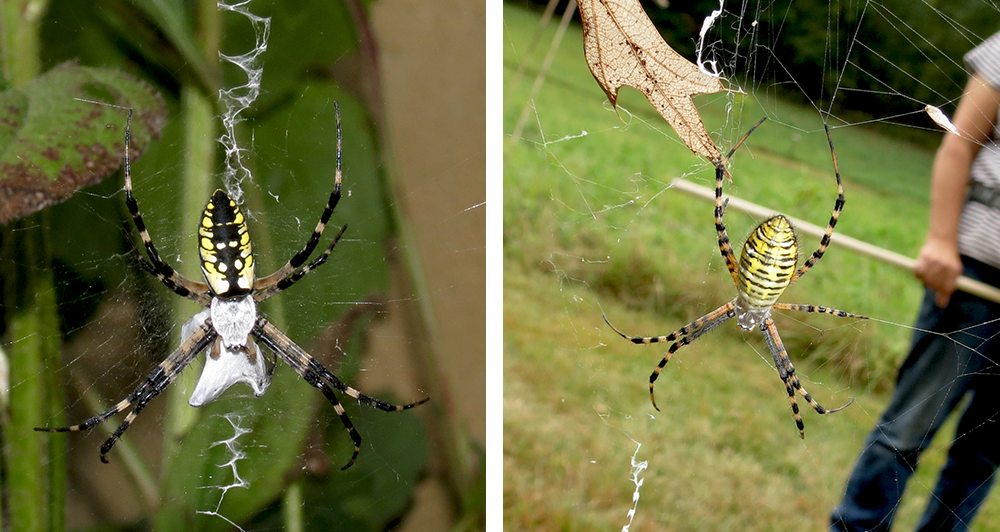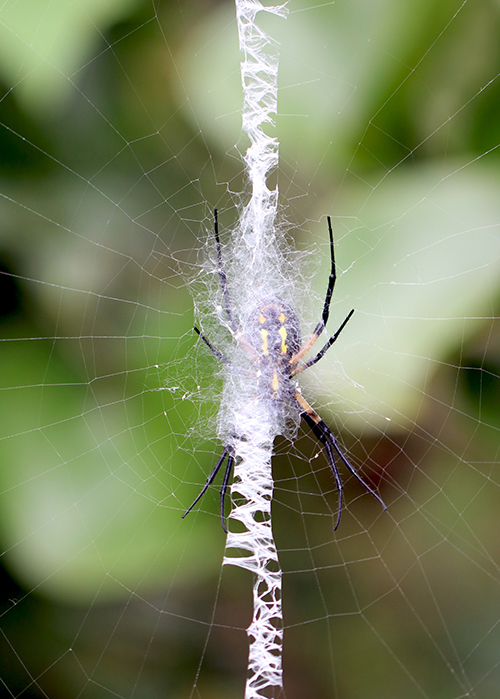Native Animal Profile: Black and Yellow Garden Spider
More than 250 species of spiders can be found in Maryland and one of the largest and more visible species is the black and yellow garden spider (Argiope aurantia). Also affectionately known as the writing spider, the black and yellow garden spider fashions an intricate zig-zag pattern in the center of its web. This extra weave is known as a stabilimentum. The purpose of the stabilimentum is still not known. Its reflection helps larger animals (like ourselves) see the web to avoid walking through, but it also may help to attract smaller prey.
Female black and yellow garden spiders are much larger than males. Typically, the length for females (not counting legs) is ¾ to 1 inch and males are about ¼ inch in length. The head (cephalothorax) on females is tipped in silver hairs and the abdomen (butt) has a yellow and black pattern. Males often hold their front and hind legs together forming a cross-like appearance. A similar species, the banded garden spider (Argiope trifasciata), can also be found in Maryland. It has horizontal lines across the abdomen.
Black and yellow garden spiders often build their webs in open areas, such as in gardens and grasslands. As part of the orbweaver family, these spiders design intricate webs that consist of concentric rings woven together. The garden spiders rely on vibrations from critters caught in their web. They will eat just about anything that gets tangled in their sticky webs, including European hornets and yellowjackets. Sometimes, the webs can be up to two feet in diameter! At night, the black and yellow garden spider will consume its web, including any material like plant pollen that gets stuck on it. She will construct a new web the next day.

A female black and yellow garden spider (left) versus a female banded garden spider (right) by Kerry Wixted
Black and yellow garden spiders are often active during the day. If a larger organism gets too close to the web, the female will often bounce up and down to make the web vibrate. These spiders mate in the fall and lay a silken cocoon almost an inch in diameter. The young will develop in the cocoon and will emerge the following spring.
These spiders rarely bite and do not have medically significant venom. If a particular spider is becoming a nuisance, then gently knock the web down with a broom or spray it down with the hose. Most spiders will relocate after their web has been destroyed a few times.
For more information on common spiders of Maryland, check out our Maryland spider webpage.
References:
Hammond, G. 2002. Argiope aurantia. Animal Diversity Web. https://animaldiversity.org/accounts/Argiope_aurantia/ Accessed September 24, 2020.
Happy Fall!
Spending more time at home means I’m spending more time in the backyard. I have been in awe at the sights I have missed over the years. Lately, I have been watching the backyard monarchs as if they were my own children! As the days get shorter, here are a few things to consider this time of year:
I’m also excited to announce the new Wild Acres public events page which will feature upcoming webinars sponsored by the Wildlife and Heritage Service. In addition, the Gardening for Pollinators webinar is now available on-demand. HabiChat subscribers will receive webinar updates as they are scheduled.
Furthermore, if you are in need of trees and shrubs for conservation or lumber, check out the Maryland State Tree Nursery which will soon be accepting orders for Spring 2021.
In this issue, you can learn about the lovely black and yellow garden spiders which can be seen this time of year, as well as information on the vigorous, native switchgrass. Additional articles include information on the importance of warm season grasses and why leaving flower stems up through the winter helps pollinators.
Happy Habitats,
Kerry Wixted
Click here to have HabiChat—the quarterly backyard wildlife habitat newsletter from the Wild Acres program—delivered right to your inbox!
In this Issue
Native Plant Profile: Switchgrass
Warm Season Grasses for Wildlife
Creating Habitat for Stem-Nesting Bees



 1-888-373-7888
1-888-373-7888 233733
233733